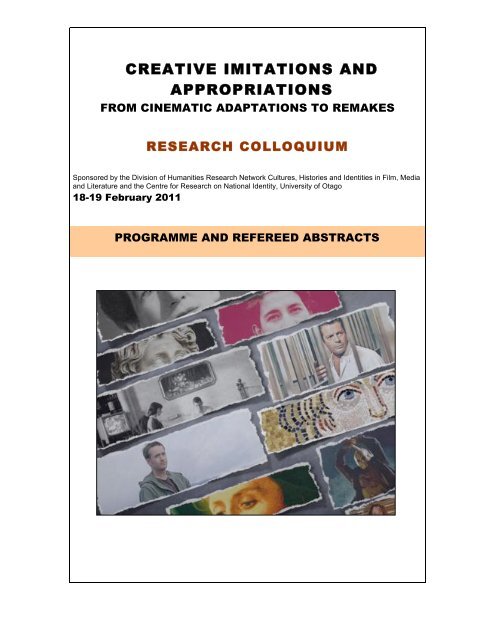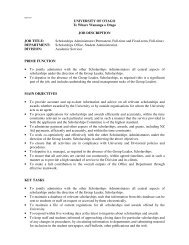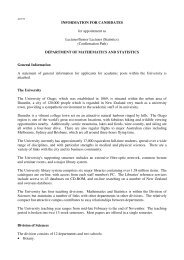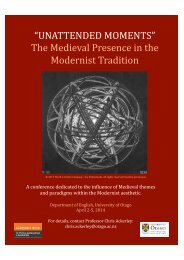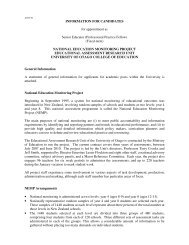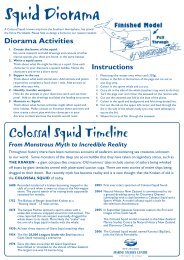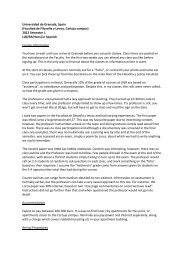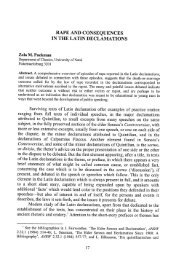CREATIVE IMITATIONS AND APPROPRIATIONS - University of Otago
CREATIVE IMITATIONS AND APPROPRIATIONS - University of Otago
CREATIVE IMITATIONS AND APPROPRIATIONS - University of Otago
Create successful ePaper yourself
Turn your PDF publications into a flip-book with our unique Google optimized e-Paper software.
<strong>CREATIVE</strong> <strong>IMITATIONS</strong> <strong>AND</strong><br />
<strong>APPROPRIATIONS</strong><br />
FROM CINEMATIC ADAPTATIONS TO REMAKES<br />
RESEARCH COLLOQUIUM<br />
Sponsored by the Division <strong>of</strong> Humanities Research Network Cultures, Histories and Identities in Film, Media<br />
and Literature and the Centre for Research on National Identity, <strong>University</strong> <strong>of</strong> <strong>Otago</strong><br />
18-19 February 2011<br />
PROGRAMME <strong>AND</strong> REFEREED ABSTRACTS
Creative Imitations and Appropriations:<br />
From Cinematic Adaptations to Re-makes<br />
Research Colloquium<br />
Programme and Refereed Abstracts<br />
Edited by Erica Todd<br />
<strong>University</strong> <strong>of</strong> <strong>Otago</strong>
Creative Imitations and Appropriations:<br />
From Cinematic Adaptations to Re-makes<br />
Edited by Erica Todd<br />
Research Colloquium<br />
Programme and Refereed Abstracts<br />
Additional Assistance: Dr Cecilia Novero, Dr Ellen Pullar,<br />
Pr<strong>of</strong>essor Hilary Radner<br />
Quality Assurance: Each proposal was reviewed by a<br />
minimum <strong>of</strong> two referees.<br />
Editorial Board: Pr<strong>of</strong>essor Alistair Fox, Dr Cecilia Novero, Dr<br />
Ellen Pullar, Pr<strong>of</strong>essor Hilary Radner<br />
Published by the Division <strong>of</strong> Humanities Research Network<br />
Cultures, Histories and Identities in Film, Media and Literature<br />
and the Centre for Research on National Identity<br />
<strong>University</strong> <strong>of</strong> <strong>Otago</strong>, Dunedin, New Zealand
Bibliographic Reference<br />
Title: Creative Imitations and Appropriations: From Cinematic<br />
Adaptations to Re-makes: Research Colloquium: Programme and<br />
Refereed Abstracts<br />
Editor: Erica Todd<br />
Publisher: Centre for Research on National Identity, <strong>University</strong> <strong>of</strong><br />
<strong>Otago</strong>, 2011<br />
ISBN: 978-0-473-18430-8<br />
© Written text copyright <strong>of</strong> authors. All rights reserved. Except for the<br />
quotation <strong>of</strong> short passages for the purpose <strong>of</strong> criticism and review,<br />
no part <strong>of</strong> this publication may be reproduced, stored in a retrieval<br />
system, or transmitted in any form by any means, electronic,<br />
mechanical, photocopying, recording or otherwise, without prior<br />
permission.<br />
All details are correct at the time <strong>of</strong> publication February 2011.
Creative Imitations and Appropriations:<br />
From Cinematic Adaptations to Re-makes<br />
Research Colloquium<br />
18-19 February 2011<br />
Sponsored by the Division <strong>of</strong> Humanities Research Network Film, Media and Literature and the<br />
Centre for Research on National Identity, <strong>University</strong> <strong>of</strong> <strong>Otago</strong><br />
The topic <strong>of</strong> adaptation has gained renewed attention and relevance in the last<br />
ten years especially due to the constantly changing landscape <strong>of</strong> film and media<br />
technology. The recent shift from analogue to digital technology has spurred<br />
much heated controversies about the nature <strong>of</strong> cinema, and the relations<br />
between textual and visual narratives, while promoting re-conceptualizations <strong>of</strong><br />
media specificity as far as both practices <strong>of</strong> production and consumption (forms<br />
and experiences <strong>of</strong> viewing) are concerned.<br />
The relevance <strong>of</strong> such debates internationally is evinced first in the conspicuous<br />
publication <strong>of</strong> key volumes devoted to such paradigm shifts (e.g., Reinventing<br />
Film Studies, 2000; Kamilla Elliott’s Rethinikng The Novel/Film Debate, 2003;<br />
Linda Hutcheon’s Theory Of Adaptation, 2006). Secondly multifarious<br />
approaches to adaptation – including within this rubric novel concepts <strong>of</strong><br />
translation as well as remakes – have been a recurrent subject <strong>of</strong> investigation at<br />
several main conferences (Modern Language Association, USA; German Studies<br />
Association, USA; American Comparative Literature Association, USA; Popular<br />
and American Culture Association, USA etc.). Finally, and most important,<br />
journal issues as well as entire refereed journals have sprung around the reinvented<br />
field <strong>of</strong> adaptation studies (i.e., Gegenwartsliterature, vol 7 (2008); and<br />
the new journal, Adaptation, edited by Deborah Cartmell, Timothy Corrigan and<br />
Imelda Whelehan, and published by Oxford <strong>University</strong> Press).<br />
Against this theoretical and historical backdrop, our colloquium investigates how<br />
adaptation – in its broadest meaning and function – becomes a key medium <strong>of</strong><br />
expression to register cultural shifts, such as those concerning, among others,<br />
national belonging, gender boundaries, generational relations, and literary<br />
canons.<br />
Convenors: Cecilia Novero, Hilary Radner<br />
Co-Convenors: Ellen Pullar, Erica Todd<br />
1
Colloquium Programme<br />
All panels will be held in the Barclay Theatre, <strong>Otago</strong> Museum with the exception <strong>of</strong> the Keynote<br />
address which will take place in Quad 2 Theatre, <strong>University</strong> <strong>of</strong> <strong>Otago</strong>.<br />
Friday, 18 February 2011<br />
Barclay Theatre, <strong>Otago</strong> Museum<br />
Welcome<br />
1.45-2.00pm<br />
Hilary Radner<br />
Introduction<br />
2.00-2.30pm<br />
Alistair Fox<br />
Screening Great Works<br />
2.30-3.45pm<br />
Chair: Alistair Fox<br />
Kluge, Eisenstein and Marx: Filming Das Kapital<br />
Simon Ryan (Department <strong>of</strong> Languages and Cultures, <strong>University</strong> <strong>of</strong> <strong>Otago</strong>)<br />
Re-reading L'Etranger: On Luchino Visconti's Adaptation <strong>of</strong> Camus' Novel<br />
Constantin Grigorut (Department <strong>of</strong> Languages and Cultures, <strong>University</strong> <strong>of</strong> <strong>Otago</strong>)<br />
The Influence <strong>of</strong> Censorship on Vincente Minnelli’s Adaptation <strong>of</strong> Madame Bovary<br />
Kerri Kilner (Department <strong>of</strong> Languages and Cultures, <strong>University</strong> <strong>of</strong> <strong>Otago</strong>)<br />
Hollywood Remakes<br />
4.00-4.50pm<br />
Chair: Erica Todd<br />
Break<br />
3.45-4.00pm<br />
Femininity, Domesticity and Gender Relations in the Two Versions <strong>of</strong> The Stepford<br />
Wives<br />
Clément Da Gama (Department <strong>of</strong> Media, Film and Communication, <strong>University</strong> <strong>of</strong><br />
<strong>Otago</strong> and Université de Paris X)<br />
“His Name Was Jason”: Intertextuality and the Remaking <strong>of</strong> Friday the 13 th<br />
Jo Murphy (Department <strong>of</strong> Film, Media and Communication, <strong>University</strong> <strong>of</strong> <strong>Otago</strong>)<br />
Break<br />
4.50-5.15pm<br />
2
Keynote Address<br />
5.15-6.15pm: Quad 2 Theatre, <strong>University</strong> <strong>of</strong> <strong>Otago</strong><br />
Introduction: Jon Hall<br />
Oliver Stone’s Alexander: the Adaptation <strong>of</strong> History and Historical Adaptation<br />
Arthur J. Pomeroy (Department <strong>of</strong> Classics, <strong>University</strong> <strong>of</strong> Victoria, Wellington)<br />
Reception<br />
6.30pm: Ombrellos Café and Bar<br />
Saturday, 19 February 2011<br />
Barclay Theatre, <strong>Otago</strong> Museum<br />
Day 2 Welcome<br />
9.15-9.30am<br />
Ellen Pullar<br />
Classical Studies and Cinema<br />
9.30-10.45am<br />
Chair: Arthur J. Pomeroy<br />
The Good, the Bad, and the Indifferent: Cinematic and Televisual Adaptation <strong>of</strong> Classical<br />
Texts<br />
Gordon Turner (Department <strong>of</strong> Classics, <strong>University</strong> <strong>of</strong> <strong>Otago</strong>)<br />
The Battle <strong>of</strong> Thermopylae: Herodotus’ Histories and 300 (2007)<br />
Matthew Sibley (Department <strong>of</strong> Classics, <strong>University</strong> <strong>of</strong> <strong>Otago</strong>)<br />
Adapting Antony And Cleopatra: How a Marriage <strong>of</strong> Convenience Became the Greatest<br />
Love Story Ever Told<br />
Dean Alexander (Department <strong>of</strong> Classics, <strong>University</strong> <strong>of</strong> <strong>Otago</strong>)<br />
Classical Hollywood Appropriations<br />
11.05am-11.55am<br />
Chair: Cecilia Novero<br />
Break<br />
10.45-11.05am<br />
Pépé le Moko (1937), Cinematic Appropriations, and the Passionate Love Story<br />
Erica Todd (Department <strong>of</strong> Media, Film and Communication and Anthropology,<br />
Gender and Sociology, <strong>University</strong> <strong>of</strong> <strong>Otago</strong>)<br />
Anita Loos, Jean Harlow and Gentlemen Prefer Blondes<br />
Ellen Pullar (Departments <strong>of</strong> Media Film and Communication and Anthropology,<br />
Gender and Sociology, <strong>University</strong> <strong>of</strong> <strong>Otago</strong>)<br />
3
Collective Memories<br />
1.25pm- 2.40pm<br />
Chair: Harriet Margolis<br />
Lunch Break<br />
11.55am-1.25pm<br />
No Country for Women? – The New Zealand Female Biopic<br />
Hilary Radner (Department <strong>of</strong> History and Art History, <strong>University</strong> <strong>of</strong> <strong>Otago</strong>)<br />
Re-mediating Unmarried Motherhood: A Comparative Analysis <strong>of</strong> Renée's Does This<br />
Make Sense to You? (1995) and Piece <strong>of</strong> My Heart (2009)<br />
Gabrielle Hine (Departments <strong>of</strong> Media Film and Communication and Anthropology,<br />
Gender and Sociology, <strong>University</strong> <strong>of</strong> <strong>Otago</strong>)<br />
Adaptation as Palimpsest <strong>of</strong> Collective Memories<br />
Cecilia Novero (Department <strong>of</strong> Languages and Cultures, <strong>University</strong> <strong>of</strong> <strong>Otago</strong>)<br />
Break<br />
2.40-3.00pm<br />
New Zealand National Literature and Cinema<br />
3.00-4.15pm<br />
Chair: Gabrielle Hine<br />
Cinematic Adaptation, Auteur Cinema, and Inter-generational Change: The Case <strong>of</strong><br />
Roger Donaldson’s Sleeping Dogs (1977)<br />
Alistair Fox (Department <strong>of</strong> English, <strong>University</strong> <strong>of</strong> <strong>Otago</strong>)<br />
“…Essentially It’s The Same Story”: Maurice Gee, Brad McCann and the Creative<br />
Adaptation <strong>of</strong> In My Father’s Den<br />
Lawrence Jones (Department <strong>of</strong> English, <strong>University</strong> <strong>of</strong> <strong>Otago</strong>)<br />
A Crime Story?<br />
Harriet Margolis (Wellington-Based Independent Researcher)<br />
Closing Speaker: Future Landscapes<br />
4.15-4.40pm<br />
Chair: Cecilia Novero<br />
Adaptating [sic] Texts: the Beauty <strong>of</strong> Machinic Perfection and Human Error<br />
David Ciccoricco (Department <strong>of</strong> English, <strong>University</strong> <strong>of</strong> <strong>Otago</strong>)<br />
Colloquium Close<br />
4.40-5.00pm<br />
Closing Remarks: Cecilia Novero<br />
4
ABSTRACTS<br />
Adapting Antony And Cleopatra: How A Marriage Of<br />
Convenience Became The Greatest Love Story Ever Told<br />
Dean Alexander<br />
In the blurb to Cecil B. DeMille’s Cleopatra (1934), the Egyptian queen, played by<br />
iconic 30s star Claudette Colbert, is described as “man hungry.” This unflattering<br />
description encapsulates the general perception <strong>of</strong> Cleopatra in popular culture:<br />
she was a femme fatale, a beautiful seductress who ensnared the most powerful<br />
men in the world by the force <strong>of</strong> her alluring femininity. However, the historical<br />
Cleopatra was markedly different from her stage and film personae. Indeed, the<br />
Greek biographer and philosopher Plutarch relates that she was a clever polyglot<br />
who had an angelic voice (Plut. Ant. 27.2-4). Her beauty, by contrast, was not<br />
“incomparable.”<br />
This paper will focus on another aspect <strong>of</strong> the romanticized legacy <strong>of</strong> Cleopatra:<br />
her marriage to Marc Antony. What was historically a marriage <strong>of</strong> convenience,<br />
poets, dramatists and filmmakers transformed into the “greatest love story <strong>of</strong> all<br />
time.” Using Plutarch’s Life <strong>of</strong> Antony, the story <strong>of</strong> Antony and Cleopatra (a story<br />
re-interpreted by such literary figures as Boccaccio, Chaucer and Shakespeare)<br />
becomes a tragic tale <strong>of</strong> ill-fated love. It is this that is emphasised in the films<br />
examined: Cleopatra (1934); Cleopatra (1963). Ultimately, I intend to trace the<br />
evolution <strong>of</strong> this remark-able transformation.<br />
Adaptating [sic] Texts: the Beauty <strong>of</strong> Machinic Perfection<br />
and Human Error<br />
David Ciccoricco<br />
This paper aims to address “adaptation” in the context <strong>of</strong> literary texts, both as<br />
they migrate from one medium (print) to another (digital), and how works <strong>of</strong><br />
digital-literary art themselves change (kinetically/visually/cinematically/virtually)<br />
on the screen as we read them. More specifically, I will invoke Lev Manovich's<br />
celebrated but blatantly instrumental notion <strong>of</strong> a new avant-garde – which he<br />
locates in computing and s<strong>of</strong>tware potential – to consider what is at stake when<br />
we effectively “technologise” operations <strong>of</strong> the imagination, while still maintaining<br />
5
that (visual, kinetic, recombinant) works <strong>of</strong> digital literature require that we<br />
redefine classical notions <strong>of</strong> literary creativity. Against Manovich, I'll consult Erik<br />
Loyer's Web-based digital fiction "The Lair <strong>of</strong> the Marrow Monkey" (1998) for an<br />
example <strong>of</strong> what digital-literary art is actually saying about the creative<br />
communion <strong>of</strong> humans and machines.<br />
Femininity, Domesticity and Gender Relations in the Two<br />
Versions <strong>of</strong> The Stepford Wives<br />
Clément Da Gama<br />
This paper proposes to examine the representation <strong>of</strong> couples and housewives in<br />
the film The Stepford Wives (1975), and its 2004 remake. Through a study <strong>of</strong> the<br />
complex relations between the two Stepford Wives, I investigate how each film<br />
represents domesticity and gender conflicts, examining the processes <strong>of</strong><br />
modification, imitation and re-mediation that are at the basis <strong>of</strong> the remake<br />
phenomenon.<br />
In the first version <strong>of</strong> The Stepford Wives, the men are represented as<br />
threatening and murderous husbands; their desire to control and destroy their<br />
wives is clearly portrayed in a negative light by the director Brian Forbes. The<br />
2004 remake, in contrast, tries to justify this male backlash by turning the male<br />
characters into victims <strong>of</strong> the current so called “crisis <strong>of</strong> masculinity.” By doing so,<br />
the remake justifies the chauvinistic attitude <strong>of</strong> the husbands, as these are now<br />
represented as victims <strong>of</strong> their career-obsessed wives. By introducing this notion<br />
<strong>of</strong> a crisis <strong>of</strong> masculinity, the remake exploits the possibilities <strong>of</strong> adaptation to<br />
reverse the feminist ideology <strong>of</strong> the first film.<br />
Cinematic Adaptation, Auteur Cinema, and Intergenerational<br />
Change: The Case <strong>of</strong> Roger Donaldson’s<br />
Sleeping Dogs (1977)<br />
Alistair Fox<br />
In all cinemas, adaptation <strong>of</strong> literary works plays an important role in registering<br />
shifts <strong>of</strong> cultural and aesthetic predispositions. This is particularly true <strong>of</strong> national<br />
cinemas, including that <strong>of</strong> New Zealand. By analysing the changes that occurred<br />
in the adaptation <strong>of</strong> a significant New Zealand novel published in the 1970s – C.<br />
K. Stead’s Smith’s Dream (1971), adapted as Sleeping Dogs by Roger<br />
Donaldson in 1977 – this paper demonstrates how the use <strong>of</strong> generic and stylistic<br />
elements specific to cinema can be used to convert adaptation <strong>of</strong> a literary work<br />
6
into an expression <strong>of</strong> the epistemic changes that can occur between generations.<br />
Sleeping Dogs also contains autobiographical elements that illustrate how the<br />
process <strong>of</strong> an adaptation can be co-opted to serve as a vehicle for the<br />
filmmaker’s engagement with whatever personal problematic he or she is<br />
preoccupied with at the time <strong>of</strong> its making. Not only does Donaldson’s film, it is<br />
argued, provide a marker <strong>of</strong> cultural change, but it also illuminates an important<br />
dimension <strong>of</strong> adaptation that has been overlooked in recent theoretical<br />
discussions <strong>of</strong> its aims, nature, and process.<br />
Re-reading L’Etranger: On Luchino Visconti’s Adaptation <strong>of</strong><br />
Camus’ Novel<br />
Constantin Grigorut<br />
Almost seventy years after its publication, Albert Camus’ L’Etranger does not<br />
cease to lose the reader in a labyrinth <strong>of</strong> interpretations. As he admitted in some<br />
interviews, Luchino Visconti planned to make an adaptation <strong>of</strong> Camus’ notorious<br />
novel immediately after the war; however, this was possible only in 1967. In my<br />
presentation, I will look at Visconti’s adaptation from three different angles: those<br />
<strong>of</strong> the filmmaker, <strong>of</strong> the virtual viewer and <strong>of</strong> the virtual re-reader <strong>of</strong> the novel.<br />
Re-mediating Unmarried Motherhood: A Comparative<br />
Analysis <strong>of</strong> Renée’s Does This Make Sense To You? (1995)<br />
and Piece <strong>of</strong> My Heart (2009)<br />
Gabrielle Hine<br />
Piece <strong>of</strong> My Heart, Fiona Samuel’s 2009 television film, is an adaptation <strong>of</strong> the<br />
novel Does This Make Sense To You? (1995) by the New Zealand activist and<br />
playwright known as Renée. Renée’s fictional tale is based on letters received<br />
from New Zealand women about their experiences with unmarried motherhood<br />
and closed adoption in the 1950s and 1960s. Accordingly, Samuel’s film is an<br />
interpretation <strong>of</strong> a fictional novel based upon a compilation <strong>of</strong> collective memories<br />
and historical research. This presentation argues that Does This Make Sense To<br />
You? and Piece <strong>of</strong> My Heart tell different stories, yet are united by a common<br />
agenda. Both are at their core an emotional appeal to remember the past in the<br />
midst <strong>of</strong> a shifting cultural milieu.<br />
7
“…Essentially It’s The Same Story”: Maurice Gee, Brad<br />
McCann and the Creative Adaptation <strong>of</strong> In My Father’s Den<br />
Lawrence Jones<br />
In My Father’s Den, Brad McCann’s 2004 adaptation <strong>of</strong> Maurice Gee’s 1972<br />
novel <strong>of</strong> the same title, has been hailed as “that rare type <strong>of</strong> adaptation: one that<br />
doesn’t just successfully translate a great book… but just as successfully updates<br />
it and refreshes it, finding new ways into its difficult emotions, amplifying and<br />
renewing its themes.” McCann himself said, “Maurice and I have grown up in<br />
different generations <strong>of</strong> New Zealand, but essentially we are struggling to speak<br />
about similar things. The way we tell it is different, but essentially it’s the same<br />
story.” This presentation will attempt to show that each was attempting to find for<br />
his generation and his medium a way to express what Gee called “the dark<br />
undercurrents <strong>of</strong> the story.”<br />
The Influence <strong>of</strong> Censorship on Vincente Minnelli’s<br />
Adaptation <strong>of</strong> Madame Bovary<br />
Kerri Kilner<br />
This paper will look at the effects <strong>of</strong> the Motion Picture Production Code and the<br />
Classical Hollywood studio system on Vincente Minnelli’s 1949 adaptation <strong>of</strong> the<br />
Gustave Flaubert’s novel Madame Bovary. Upon its publication in 1856, Madame<br />
Bovary was immediately condemned and Flaubert prosecuted for “immorality”<br />
due to the novel’s treatment <strong>of</strong> such themes as adultery and suicide. These same<br />
themes were also problematic for Minnelli’s adaptation because Hollywood films<br />
<strong>of</strong> the era were rigorously controlled by the Production Code. I shall examine the<br />
changes that were made in the film to satisfy the Code, the consequences this<br />
had on the themes and characterisations as portrayed in the novel, and the<br />
effects that the Classical Hollywood studio system’s conventions and<br />
organisational structures (in relation to casting, sets and costumes, for example)<br />
had on the film. I argue that because <strong>of</strong> censorship and the overwhelming<br />
influence <strong>of</strong> MGM, the film is more representative <strong>of</strong> American values – and<br />
Classical Hollywood types and conventions – than the themes <strong>of</strong> the original<br />
French novel.<br />
8
A Crime Story?<br />
Harriet Margolis<br />
Maurice Gee’s Crime Story appeared in 1994. A labour <strong>of</strong> love, Larry Parr’s<br />
Fracture (2004) appeared a decade later, hampered by bad publicity surrounding<br />
the collapse <strong>of</strong> Kahukura, Parr’s production company, and the success <strong>of</strong> Brad<br />
McGann’s adaptation <strong>of</strong> Maurice Gee’s In My Father’s Den, which appeared at<br />
the same time. Gee’s novel interlinks stories <strong>of</strong> two families when a thief from<br />
one family seriously injures a member <strong>of</strong> the other family. Guilt, though, takes<br />
many forms, just as what we admire varies with point <strong>of</strong> view. Has Parr’s film<br />
done justice to Gee’s book?<br />
“His Name Was Jason”: Intertextuality and the Remaking <strong>of</strong><br />
Friday the 13th<br />
Jo Murphy<br />
The remaking <strong>of</strong> horror films is certainly not a new phenomenon; however in the<br />
last five years the number <strong>of</strong> horror remakes has increased significantly, and <strong>of</strong><br />
all these remakes, there are none so prolific as the remakes <strong>of</strong> iconic 80s slasher<br />
films Halloween (1978), A Nightmare on Elm Street (1984), and Friday the 13 th<br />
(1980). My research argues that the slasher remake shows a distinct and<br />
unprecedented method <strong>of</strong> remaking, making use <strong>of</strong> intertexts, image replication,<br />
allusion to critical discourse around the original films and incorporation <strong>of</strong> content<br />
from their numerous sequels in order to appeal to both pre-existing fans, and<br />
those with only a superficial engagement with this pop cultural phenomenon. It<br />
further suggests that this form <strong>of</strong> remaking is related to developments within the<br />
slasher sub-genre as a whole, with particular reference to Scream (1996) and the<br />
1990s slasher revival.<br />
This presentation will use the Platinum Dunes remake <strong>of</strong> Friday the 13th (2009)<br />
to illustrate exactly how the slasher remake differs from previous forms and<br />
patterns <strong>of</strong> remaking, and discuss how the content that this remake retains from<br />
the original franchise has been strongly influenced by references to Jason<br />
Vorhees in popular culture.<br />
9
Adaptation as Palimpsest <strong>of</strong> Collective Memories<br />
Cecilia Novero<br />
Scholar Eric Rentschler strongly criticized the German films <strong>of</strong> the 1990s for their<br />
popular (yet provincial) appeal, their anxiety about success and thus their<br />
unreflected reproduction <strong>of</strong> mainstream cinema. Rentschler launches his critique<br />
<strong>of</strong> the “cinema <strong>of</strong> consensus” – as he named it – through the lens <strong>of</strong> the New<br />
German Cinema <strong>of</strong> the 1960s and 1970s that, as is known, used adaptation as<br />
discursive critique. Another critic, Timothy Corrigan, has later argued that<br />
adaptations, especially <strong>of</strong> literary classics (from Shakespeare to Jane Austen,<br />
etc.), have gained prominence on the European screens since 1989. Adaptations<br />
have indeed also returned on the German screen, namely after the national<br />
success and international flop <strong>of</strong> the “cinema <strong>of</strong> consensus” described above.<br />
Several questions then arise when considering the phenomenon in the German<br />
context. Two issues seem prominent: 1) What kinds <strong>of</strong> text have been adapted<br />
for the German screen, and why these texts? 2) How do recent adaptations<br />
position themselves with respect to the Young and New German Cinema’s<br />
counter-historical approach to the German library, e.g., German Kultur and the<br />
bourgeois public sphere (see Fassbinder, Herzog, Wenders, but also the more<br />
experimental films by Kluge, Achternbusch and Straub-Huillet)? In other words,<br />
are contemporary adaptations an escape from German national history? Are they<br />
a way to construct the German “past” as “non-exceptional”? Do they stand for 1)<br />
an affirmative – regressive – move? Are they, alongside the cinema <strong>of</strong><br />
consensus, a commercial enterprise intended to normalize German history? Or,<br />
2) if they remember the New German Cinema, do they reactivate the critical<br />
energy <strong>of</strong> adaptation that this Cinema entailed? My paper pursues some <strong>of</strong> these<br />
questions as they surface when dealing with one specific past: the GDR state<br />
that ended in 1989. To tackle the more general question <strong>of</strong> how post-wall<br />
German adaptations confront the “multiple” German pasts, especially the division<br />
<strong>of</strong> Germany, my paper investigates whether adaptation as it emerges from the<br />
vanishing point <strong>of</strong> the GDR has transformed into a minor genre <strong>of</strong> collective<br />
enunciation.<br />
The paper analyses the recent German adaptation <strong>of</strong> Willenbrock, a novel by<br />
GDR writer Christoph Hein. The novel came out in 2000, about 10 years after the<br />
fall <strong>of</strong> the wall, and was hailed by some critics as the much awaited<br />
Wenderoman, the novel about German unification. Andreas Dresen adapted<br />
Willenbrock in 2005, when – in his view – unification and the history that led up to<br />
it did not appear to be as important as the takeover <strong>of</strong> economic paradigms <strong>of</strong><br />
globalisation that succeeded it. In spite <strong>of</strong> Dresen’s statement, and possibly<br />
embedded within it, the film shows that instead the “past” returns as key<br />
phantasmatic operation, indeed as the engine <strong>of</strong> this (and other GDR)<br />
adaptations. Dresen himself was born in the former GDR where he also studied<br />
directing. However he “came <strong>of</strong> age” as cinematic director in united Germany. My<br />
analysis demonstrates that contemporary German adaptations in which the GDR<br />
10
past plays some role add to the intertextuality <strong>of</strong> this genre two interconnected<br />
and national-specific dimensions: namely the idea <strong>of</strong> memory as textual<br />
palimpsest on the one hand, and the notion <strong>of</strong> collective-enunciation, on the<br />
other. For the latter I rely on Deleuze and Guattari’s definition in their seminal<br />
work on Kafka and minor literature. I argue that adaptation <strong>of</strong>fers the collective<br />
mnemonic filter through which to confront homogeneous constructions <strong>of</strong><br />
“national memory” and any attempt at fixing the past.<br />
Oliver Stone’s Alexander: the Adaptation <strong>of</strong> History and<br />
Historical Adaptation<br />
Arthur J. Pomeroy<br />
When Oliver Stone made his film <strong>of</strong> the life <strong>of</strong> Alexander the Great, he saw this<br />
as his masterpiece, the application <strong>of</strong> what <strong>of</strong> he had learned from making<br />
movies about modern political events and politicians to the life <strong>of</strong> the most<br />
charismatic European leader whose military achievements left a lasting mark on<br />
global history. However, the film, while not a box-<strong>of</strong>fice disaster, did only<br />
respectable business and Stone himself reedited his footage twice in an attempt<br />
to make amends for “having failed Alexander.”<br />
Explanations for Alexander’s lack <strong>of</strong> success abound: too many special interest<br />
groups felt they owned the subject for international success (Gideon Nisbet);<br />
Stone’s confused treatment <strong>of</strong> Alexander’s sexuality overshadowing the<br />
(politically shaky) tale <strong>of</strong> successful western imperialism (papers in Berti/Morcillo<br />
and Cartledge/Greenland); an excessive concern with the problems <strong>of</strong> the<br />
historical tradition (encapsulated in the film in the figure <strong>of</strong> Ptolemy) and an<br />
outdated, romantic slant underpinned by the film’s historical advisor, Robin Lane<br />
Fox.<br />
Instead, I would like to situate Stone’s project within the traditions <strong>of</strong> Hollywood<br />
filmmaking, with particular regard to three forms <strong>of</strong> adaptation that have a<br />
pr<strong>of</strong>ound effect on the film and indicate the difficulties in reconciling these:<br />
(a) the cinematic tradition, represented by Robert Rossen’s Alexander the Great;<br />
(b) the historical novel, represented by Mary Renault’s Alexander trilogy;<br />
(c) the romantic ancient tradition whose standard-bearers are Plutarch (Life <strong>of</strong><br />
Alexander) and Arrian.<br />
11
Anita Loos, Jean Harlow and Gentlemen Prefer Blondes<br />
Ellen Pullar<br />
This paper shall investigate the influence <strong>of</strong> writer/screenwriter Anita Loos (1888-<br />
1981) and her best-seller novel, Gentlemen Prefer Blondes (originally published<br />
1925), on the star persona <strong>of</strong> Jean Harlow (1911-1937). Loos was employed as a<br />
screenwriter for MGM throughout the 1930s, writing the screenplays for four <strong>of</strong><br />
Harlow’s films: Red-Headed Woman (Jack Conway, 1932), The Girl From<br />
Missouri (Jack Conway, 1934), Riffraff (J. Walter Ruben, 1936), Saratoga (Jack<br />
Conway, 1937). In addition to scripting these films, Loos appeared in publicity<br />
photographs with Harlow, which promoted these films, and she was called upon<br />
by the studio to pen features on Harlow for the fan magazines. In Harlow’s films,<br />
as well as her publicity materials, she is repeatedly cast in relation to the platinum<br />
blonde bombshell character type, a type that Loos had famously featured as the<br />
protagonist <strong>of</strong> Gentlemen Prefer Blondes. The impact that Loos’ novel had on<br />
Harlow’s star persona was not a consequence <strong>of</strong> a direct adaptation; rather, it<br />
manifested itself in looser thematic borrowings. Focusing in particular on Red-<br />
Headed Woman and select publicity texts featuring Harlow, I shall consider the<br />
ways in which the platinum blonde bombshell type <strong>of</strong> Gentlemen Prefer Blondes<br />
is rearticulated and rethought in these texts with the original author’s<br />
collaboration.<br />
Collaboration between well-known authors and the Hollywood studios was<br />
common during the classical era. F. Scott Fitzgerald, for example, worked as a<br />
screenwriter during the twenties and thirties, as did Elinor Glynn. In Loos’ case, it<br />
can be seen that this was mutually beneficial for both the studio and the author.<br />
For MGM, Loos’ fame as an author could be exploited for promotional purposes.<br />
For Loos, her work as a screenwriter <strong>of</strong>fered her well-paid and creative<br />
employment as well as the opportunity to assert a female voice in the maledominated<br />
Classical Hollywood studio system.<br />
No Country for Women? – The New Zealand Female Biopic<br />
Hilary Radner<br />
To date, scholars writing on New Zealand film have overlooked an unusually<br />
large number <strong>of</strong> fiction features about New Zealand women, including the New<br />
Wave biopics, Iris (1984), Leave All Fair (1985) and Sylvia (1985), as well as the<br />
later biopics, An Angel at My Table (1990) and Bread and Roses (1993), all<br />
adaptations <strong>of</strong> successful novels or autobiographies. Failure to acknowledge<br />
these productions has led to judgments such as that <strong>of</strong> Ian Conrich, who<br />
describes New Zealand cinema’s “New Wave” (New Zealand’s films made<br />
subsequent to 1977) as “predominantly testosterone fuelled: the product <strong>of</strong> a<br />
12
male-dominated industry in which films <strong>of</strong>fered stories <strong>of</strong> aggression, stunts,<br />
pranks and subversion.” In contrast, New Zealand film historian Bruce Babington<br />
underlines that “[b]y 1985 the beginnings <strong>of</strong> a perceptible feminisation <strong>of</strong> New<br />
Zealand film are observable, not only in subject matter and emphases, but in<br />
directing personnel.” This presentation proposes to explore this “feminisation” as<br />
a form <strong>of</strong> collective memory that arises, at least in part, out <strong>of</strong> the concerns <strong>of</strong><br />
second wave feminism, serving to de-stabilize accepted national myths about<br />
“God’s own country.”<br />
Kluge, Eisenstein and Marx: Filming Das Kapital<br />
Simon Ryan<br />
In his 580-minute DVD project Nachrichten aus der ideologischen Antike (2008)<br />
Alexander Kluge engages with the relationship between text and image in the<br />
context <strong>of</strong> Eisenstein’s unrealised plan to film Marx' Das Kapital. Vilém Flusser’s<br />
observations on the nature <strong>of</strong> film code point the way to a productive continuation<br />
<strong>of</strong> the conversation between Kluge and Oskar Negt on the question <strong>of</strong> an aporia<br />
between text and image.<br />
The Battle <strong>of</strong> Thermopylae: Herodotus’ Histories and 300<br />
(2007)<br />
Matthew Sibley<br />
The Battle <strong>of</strong> Thermopylae <strong>of</strong> 480BC is a celebrated moment in Greek history<br />
and Classical scholarship. The battle, in which a Greek contingent held <strong>of</strong>f a<br />
numerically superior Persian force for several days, has captivated the minds <strong>of</strong><br />
historians, writers, artists and filmmakers since its occurrence. The Father <strong>of</strong><br />
History, Herodotus, is our most popular ancient account <strong>of</strong> the event in the 7th<br />
book <strong>of</strong> his work The Histories. The event has subsequently had a strong<br />
tradition in visual culture and film.<br />
Zach Snyder’s rendition, 300 (2007), has proved divisive with critics and<br />
scholars. Contentious elements <strong>of</strong> the film include its historical inaccuracies,<br />
depiction <strong>of</strong> the Persian force as monstrous, and simplification <strong>of</strong> the battle to a<br />
contest <strong>of</strong> good against evil, and democracy against despotism. Some scholars<br />
have defended the film on the basis that it should be read as a reinterpretation <strong>of</strong><br />
Herodotus’ literary work, rather than a purely historical film. I will follow in this line<br />
but with one amendment; the depiction <strong>of</strong> King Xerxes is antithetical <strong>of</strong><br />
Herodotus’ literary objective and requires an examination <strong>of</strong> the wider Classical<br />
tradition.<br />
13
Pépé le Moko (1937), Cinematic Appropriations, and the<br />
Passionate Love Story<br />
Erica Todd<br />
In discussions <strong>of</strong> genre and plot, much <strong>of</strong> the scholarly interest in Julien<br />
Duvivier’s Pépé le Moko (1937) focuses on its categorisation as a polar or<br />
gangster film. This acclaimed French film has <strong>of</strong>fered an important contribution to<br />
the crime genre, enriched by the style <strong>of</strong> poetic realism and star persona <strong>of</strong> Jean<br />
Gabin; however I argue that Pépé le Moko should also be considered an<br />
important influence on the conventions <strong>of</strong> passionate love story in popular<br />
cinema. Not only did the screenwriters amplify the originally minimal love story<br />
from Henri LaBarthe’s original novel, but subsequent Hollywood appropriations –<br />
Algiers (1938), Casablanca (1942), Play It Again, Sam (1972) and the Pepe le<br />
Pew character (1945-present) – have emphasised the love story further, as the<br />
original crime elements gradually become less important.<br />
It is my contention that these appropriations emphasise Pépé le Moko’s<br />
classification as a passionate love story. Given that there is little scholarly<br />
examination <strong>of</strong> the film as, I hope to contribute a new perspective to the existing<br />
analyses <strong>of</strong> this acclaimed French classic.<br />
The Good, the Bad, and the Indifferent: Cinematic and<br />
Televisual Adaptation <strong>of</strong> Classical Texts<br />
Gordon Turner<br />
In classical terms, the foundation <strong>of</strong> the extant textual evidence for the Trojan<br />
War and Helen <strong>of</strong> Troy is Homer’s Iliad (which covers a period <strong>of</strong> 51 days in the<br />
tenth year <strong>of</strong> the war), supplemented by other ancient sources that relate events<br />
that occurred before and after that short period <strong>of</strong> time. However, there is no<br />
extant evidence that there ever was a Trojan War or, if there was, when it took<br />
place; or that there ever was a Helen <strong>of</strong> Troy. In cinematic terms, stories <strong>of</strong> the<br />
Trojan War and Helen <strong>of</strong> Troy have been popular subjects in movies for at least<br />
the past century, with La Caduta di Troia (The Fall <strong>of</strong> Troy) appearing in 1911,<br />
and have also been represented more recently on television. Four <strong>of</strong> these<br />
cinematic and televisual representations are Helen <strong>of</strong> Troy (1956), directed by<br />
Robert Wise; L’Ira di Achille (The Fury <strong>of</strong> Achilles) (1962), directed by Marino<br />
Girolami; the episode “Revenge <strong>of</strong> the Gods” (1966), directed by Nathan Juran<br />
and Sobey Martin, from season 1 <strong>of</strong> the television series The Time Tunnel; and<br />
Troy (2004), directed by Wolfgang Petersen. These four cinematic and televisual<br />
representations follow Homer’s ancient evidence <strong>of</strong> plot and character, as<br />
supplemented, to a greater or lesser extent. They also differ radically between<br />
14
themselves in these respects. This paper will introduce these differences. It will<br />
then argue whether the values “good,” “bad” and “indifferent” should be applied to<br />
these cinematic and televisual adaptations <strong>of</strong> classical texts.<br />
15
Colloquium Participants<br />
Keynote Speaker<br />
Arthur Pomeroy, Pr<strong>of</strong>essor <strong>of</strong> Classics, <strong>University</strong> <strong>of</strong> Victoria, Wellington<br />
Arthur.Pomeroy@vuw.ac.nz<br />
Presenters<br />
Dean Alexander, PhD candidate, Classics, <strong>University</strong> <strong>of</strong> <strong>Otago</strong><br />
alede978@student.otago.ac.nz<br />
David Ciccoricco, Lecturer in English, <strong>University</strong> <strong>of</strong> <strong>Otago</strong><br />
dave.ciccoricco@otago.ac.nz<br />
Clément Da Gama, PhD Candidate, Film and Media Studies, <strong>University</strong> <strong>of</strong> <strong>Otago</strong><br />
and Histoire et esthétique, Université de Paris X<br />
clement.da.gama@gmail.com<br />
Alistair Fox, Pr<strong>of</strong>essor <strong>of</strong> English, <strong>University</strong> <strong>of</strong> <strong>Otago</strong><br />
alistair.fox@otago.ac.nz<br />
Constantin Grigorut, Senior Lecturer in French, <strong>University</strong> <strong>of</strong> <strong>Otago</strong><br />
constantin.grigorut@otago.ac.nz<br />
Gabrielle Hine, PhD candidate, Film and Media Studies and Gender Studies,<br />
<strong>University</strong> <strong>of</strong> <strong>Otago</strong><br />
hinga301@student.otago.ac.nz<br />
Lawrence Jones, Emeritus Pr<strong>of</strong>essor <strong>of</strong> English, <strong>University</strong> <strong>of</strong> <strong>Otago</strong><br />
hardzeal@callsouth.net.nz<br />
Kerri Kilner, PG Dip Arts, French, <strong>University</strong> <strong>of</strong> <strong>Otago</strong><br />
kilke630@student.otago.ac.nz<br />
16
Harriet Margolis, PhD, Comparative Literature and Film Studies, <strong>University</strong> <strong>of</strong><br />
Indiana, Bloomington<br />
tarkiwi@paradise.net.nz<br />
Jo Murphy, MA candidate, Film and Media Studies, <strong>University</strong> <strong>of</strong> <strong>Otago</strong><br />
jo.mary.murphy@gmail.com<br />
Cecilia Novero, Senior Lecturer in German, <strong>University</strong> <strong>of</strong> <strong>Otago</strong><br />
novero@gmail.com<br />
Ellen Pullar, PhD, Film and Media Studies, <strong>University</strong> <strong>of</strong> <strong>Otago</strong> and Histoire et<br />
esthétique, Université de Paris X<br />
ellenpullar@yahoo.co.nz<br />
Hilary Radner, Pr<strong>of</strong>essor <strong>of</strong> Film and Media Studies<br />
hilary.radner@otago.ac.nz<br />
Simon Ryan, Head <strong>of</strong> Department, Languages and Cultures, <strong>University</strong> <strong>of</strong> <strong>Otago</strong><br />
simon.ryan@otago.ac.nz<br />
Matthew Sibley, MA, Classics, <strong>University</strong> <strong>of</strong> <strong>Otago</strong><br />
sibma534@student.otago.ac.nz<br />
Erica Todd, PhD candidate, Film and Media Studies and Sociology, <strong>University</strong> <strong>of</strong><br />
<strong>Otago</strong><br />
toder985@student.otago.ac.nz<br />
Gordon Turner, PhD, Classics<br />
gordonturner@vodafone.co.nz<br />
17
Creative Imitations and Appropriations:<br />
From Cinematic Adaptations to Remakes<br />
Research Colloquium<br />
Sponsored by the Division <strong>of</strong> Humanities Research Network Cultures,<br />
Histories and Identities in Film, Media and Literature and the Centre for<br />
Research on National Identity, <strong>University</strong> <strong>of</strong> <strong>Otago</strong><br />
18-19 February 2011<br />
PROGRAMME <strong>AND</strong> REFEREED ABSTRACTS<br />
ISBN 978-0-473-18430-8


